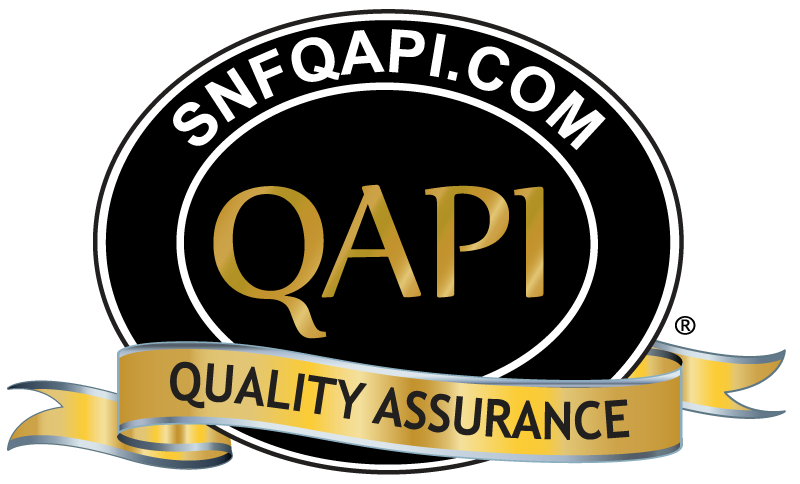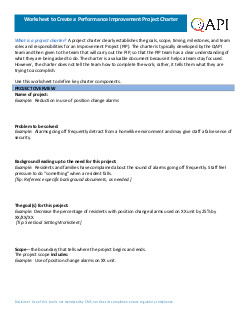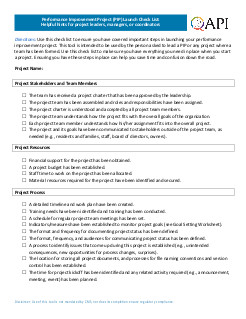12 Action Steps
STEP 9: Prioritize Quality Opportunities and Charter PIPs
Prioritizing opportunities for improvement is a key step in the process of translating data into action.
As you continue to implement QAPI, you and your team will:
- Prioritize opportunities for more intensive improvement work. Problems versus opportunities are a matter of perspective and often require discussion.
- Choose problems or issues that you consider important (consider if the issue is high risk, high frequency, and/or problem prone). Remember that problems affecting psychosocial well-being and the ability of residents to exercise choice should also be considered as they may lead to resident suffering.
- Consider which problems will become the focus for a PIP.
- All identified problems need attention—and usually from more than one person, but they do not all require PIPs.
- Begin some PIPs with problems you think you can solve relatively easily. A quick win is worthwhile.
Charter PIP teams:
We use the word “charter” on purpose. A PIP is more than a casual effort - it entails a specific written mission to look into a problem area. The PIP team should include people in a position to explore the problem (usually direct caregivers, such as nursing assistants, are needed). If the problem being addressed involves, for example, dietary choices, then someone from the dietary department should also be on the PIP team.
Chartering implies that the team has been entrusted with a mission, and that it reports back to the Steering Committee at intervals. Being part of a formally chartered PIP team must be interpreted as an important assignment that team members and their supervisors must take seriously. The development of a charter adds strength, importance, and formality to the PIP process. The team typically has a leader—either chosen in the charter or by the team itself. Soon after it begins its work, the PIP should develop a proposed time line, and indicate the budget that is needed.
Use the Goal Setting Worksheet to help your PIP team establish appropriate goals for organizational quality measures, informal improvement initiatives, and PIPs.
https://www.cms.gov/medicare/provider-enrollment-and-certification/qapi/downloads/qapiataglance.pdf
Worksheet to Create a Performance Improvement Project Charter

What is a project charter? A project charter clearly establishes the goals, scope, timing, milestones, and team roles and responsibilities for an Improvement Project (PIP). The charter is typically developed by the QAPI team and then given to the team that will carry out the PIP, so that the PIP team has a clear understanding of what they are being asked to do. The charter is a valuable document because it helps a team stay focused. However, the charter does not tell the team how to complete the work; rather, it tells them what they are trying to accomplish.
Use this worksheet to define key charter components.
PROJECT OVERVIEW
Name of project:
Example: Reduction in use of position change alarms
Problem to be solved:
Example: Alarms going off frequently detract from a homelike environment and may give staff a false sense of security.
Background leading up to the need for this project:
Example: Residents and families have complained about the sound of alarms going off frequently. Staff feel pressure to do “something” when a resident falls.
[Tip: Reference specific background documents, as needed.]
The goal(s) for this project:
Example: Decrease the percentage of residents with position change alarms used on XX unit by 25% by XX/XX/XX.
[Tip: See Goal Setting Worksheet]
Scope-the boundary that tells where the project begins and ends.
Example: Decrease the percentage of residents with position change alarms used on XX unit by 25% by XX/XX/XX.
The project scope includes:
Example: Use of position change alarms on XX unit.
PROJECT APPROACH
Recommended Project Time Table:
| PROJECT PHASE | START DATE | END DATE |
|---|---|---|
| Initiation: Project charter developed and approved | ||
| Planning: Specific tasks and processes to achieve goals defined | ||
| Implementation: Project carried out | ||
| Monitoring: Project progress observed and results documented | ||
| Closing: Project brought to a close and summary report written |
Project Team and Responsibilities:
| TITLE | ROLE | PERSON ASSIGNED |
|---|---|---|
| Project Sponsor | Provide overall direction and oversee financing for the project | |
| Project Director | Coordinate, organize and direct all activities of the project team | |
| Project Manager | Manage day-to-day project operations, including collecting and displaying data from the project | |
| Team members* | ||
*Choice of team members will likely be deferred to the project manager based on interest, involvement in the process, and availability.
Material Resources Required for the Project (e.g., equipment, software, supplies):
Barriers
| What could get in the way of success? | What could you do about this? |
|---|---|
| Example: A resident could fall and staff could automatically blame the lack of an alarm. | Example: Educate staff on the lack of relationship between alarms and falls; collect data on removal of one alarm at a time. |
| Example: Staff complaints of need for additional staff to watch everyone if alarms are removed. | Example: Focus on anticipation of resident needs, and assess if additional hands-on-deck are needed during busy times on unit. |
PROJECT APPROVAL
The signatures of the people below relay an understanding and approval of the purpose and approach to this project. By signing this document you agree to establish this document as the formal Project Charter and sanction work to begin on the project as described within.
| TITLE | NAME | SIGNATURE | DATE |
|---|---|---|---|
| Administrator | |||
| Project Sponsor | |||
| Project Director* | |||
| Project Manager* |
*May not always have both roles.
Performance Improvement Project (PIP) Launch Check List: Helpful hints for project leaders, managers, or coordinators

Directions: Use this check list to ensure you have covered important steps in launching your performance improvement project. This tool is intended to be used by the person asked to lead a PIP or any project where a team has been formed. Use this check list to make sure you have everything you need in place when you start a project. Ensuring you have these steps in place can help you save time and confusion down the road.
Project Name:
Project Stakeholders and Team Members
- The team has received a project charter that has been approved by the leadership.
- The project team has been assembled and roles and responsibilities have been assigned.
- The project charter is understood and accepted by all project team members.
- The project team understands how the project fits with the overall goals of the organization.
- Each project team member understands how his/her assignment fits into the overall project.
- The project and its goals have been communicated to stakeholders outside of the project team, as needed (e.g., residents and families, staff, board of directors, owners).
Project Resources
- Financial support for the project has been obtained.
- A project budget has been established.
- Staff time to work on the project has been allocated.
- Material resources required for the project have been identified and secured.
Project Process
- A detailed timeline and work plan have been created.
- Training needs have been identified and training has been conducted.
- A schedule for regular project team meetings has been set.
- Indicators/measures have been established to monitor project goals (see Goal Setting Worksheet).
- The format and frequency for documenting project status has been defined.
- The format, frequency, and audiences for communicating project status has been defined.
- A process to identify issues that come up during this project is established (e.g., unintended consequences, new opportunities for process changes, surprises).
- The location for storing all project documents, and processes for file naming conventions and version control has been established.
- The time for project kickoff has been identified and any related activity required (e.g., announcement, meeting, event) has been planned.


